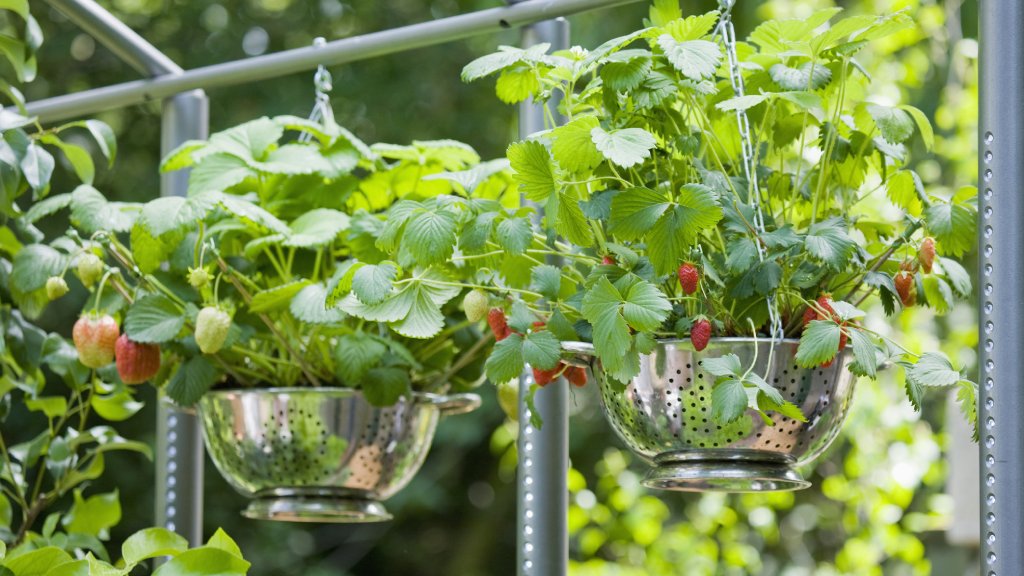
What are the best fruits and vegetables to grow in hanging baskets? The best edible plants for hanging baskets will depend on your location and preference. There’s no right or wrong answer when opting for edible hanging plants.
We’ve all seen them – those gorgeous hanging baskets filled with annual bloomers decorating the town plaza or even our own patios or decks. But these beauties can become useful as well as ornamental with the addition of edible plants for hanging baskets. Edible hanging baskets can contain a mix of edible fruits and veggies as well as annuals.
Edible Hanging Basket Considerations
Edible hanging baskets are also an excellent vertical growing idea for those with limited space. If all you have is a small lanai off your condo, hanging baskets filled with your favorite fruit and vegetables double as a garden space.
There are obviously some caveats. You can’t grow a peach tree or a full-sized tomato plant, but you can grow hanging basket cherry tomatoes and certainly hanging strawberries to augment your menu.
You will want to select the lightest weight, yet sturdiest container that has adequate drainage holes.
If your hanging basket doesn’t have sides, you will need to layer it with coconut coir or similar organic material to keep soil and plants inside.
Most fruits and veggies (and herbs) require at least 6 hours of full sun per day.
Sign up for the Gardening Know How newsletter today and receive a free copy of our e-book "How to Grow Delicious Tomatoes".
Your soil selection should be well-draining, lightweight yet organically rich.
As to how many plants can fit in your hanging basket: A container that is 8-12 inches (20-30 cm) across will hold 1-2 plants. You want to leave some room for the plant to grow so don’t overcrowd.
Make sure if you are combining hanging herbs, annuals, vegetables and fruits, that they all enjoy similar conditions of light, water, fertilizer, etc.
Lastly, you will want to think about smaller varieties of veggies and fruits that can thrive in a container. There is a finite amount of room, so opt for dwarf cultivars when available.
Best Edible Plants for Hanging Baskets
You can grow almost all the herbs in container baskets however, I’d avoid the really tall ones such as fennel.
As to fruits and vegetables, again, look for dwarf cultivars. Cherry or grape tomatoes, compact chili peppers, dwarf eggplants (Patio Baby), garden or alpine strawberries, Patio Pickle or Summer Dance cucumbers, trailing sweet potato vine, cucamelon, most types of greens or lettuces, and radishes will all work well in hanging baskets.
You can even grow the prolific zucchini in a hanging basket, but likely only one. Green or spring onions and garlic can be grown as the centerpiece of the basket surrounded by shorter plants. Tomatillos or ground cherries can be grown in hanging baskets.
Dwarf bean varieties can be grown in the center of the hanging basket while trailing varieties can hang and dangle down the sides. Any variety of pea can be grown as a hanging plant or trained up a trellis or the supports of your patio or deck.
Edible Hanging Basket Ideas
You can make your baskets really pop by adding blooming annuals or even edible bloomers such as calendula, chrysanthemum, dianthus, French marigold, fuchsia, nasturtiums, pansies or violas. Plus the bees and beneficial pollinators love the flowers and will help with pollination.
Don’t pack your basket too full with plants. Trust me on this. I know the basket looks better when it’s full, but allow the plants room to grow. Too many plants compete for nutrients and water.
Start at the center of the basket when you plant. Put the tallest plants at maturity in the center and radiate out with gradually shorter plantings. Position hanging plants at the outer edges to drape over the sides of the planter.
When possible, hang your edible baskets near the house or outdoor kitchen. If it's nearby you will not only use it, but you’ll also remember to water it.
On the subject of water, hanging planters require more water than plants in the ground. On a sunny, hot day you may end up watering them more than once a day.
You should also fertilize more frequently than you would plants in the ground; feed them lightly but more frequently. This is because there is little nutrient-rich soil for the plants to draw from and, watering the plants leaches nutrients from the container as it drains.
If you know you aren’t likely to remember to fertilize (I’m rebuking myself here), it’s a good idea to incorporate a slow-release fertilizer into the soil before potting up your plants.
Frequently Asked Questions
What Are the Best Hanging Fruits?
Both alpine and ever-bearing strawberries, dwarf or ground blueberries, raspberries (Ruby Fall or Raspberry Shortcake), and Baby Cake or Cascade blackberries can all be grown in hanging baskets. If we go by the botanical definition of “fruit,” our list expands to include various cucumbers, cherry or grape tomatoes, dwarf eggplant, and even zucchini.
Can You Grow Cucumbers in a Hanging Basket?
Yes, cucumbers can be grown in hanging baskets. It’s a good idea to select from smaller-sized fruits such as Picolino, Spacemaster, Mini Munch, Lemon and Apple cucumbers.

Amy Grant has been gardening for 30 years and writing for 15. A professional chef and caterer, Amy's area of expertise is culinary gardening.
